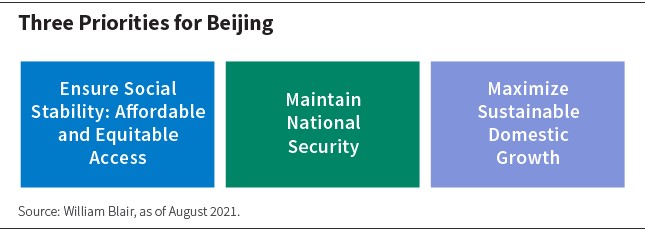The rise of China’s digital champions has been an engine of innovation and growth and a compelling investment opportunity over the past years.
As the market focuses on Beijing’s latest commentary and regulatory announcements, with the sentiment swings that naturally come along with the sudden shock, we believe it is important to step back and analyze the series of recent events with a broader perspective.
Our assessment of the current situation in Chinese equities is framed by asking two simple questions: What has not changed, and what may, in fact, be changing? Ignoring the former or miscalculating the latter could result in either abundant risks or significant opportunity costs for investors.
What Has Not Changed
China’s transformation and search for growth has been constant over the past four decades. So too has been its socialist ideological system and autocratic regime. But the shift to a capitalist-oriented economy has underpinned China’s successful economic growth over recent years, making it the second-largest world economy with significant global influence.
Beijing has not abandoned its growth objectives and has clearly stated its aim to double the size of its economy by 2035. In addition, Beijing is committed to the continued development of its capital markets in alignment with its growth ambitions and current stage of development.
Over the past several decades, the world has witnessed the transformation of China from a smokestack economy to a labtech economy. The country has become an economic superpower with some of the most innovative and fastest-growing industries and companies in the world.
This development has not been accidental; it has been fueled by the Chinese Communist Party’s (CCP’s) long-term plan to generate enough growth to transform the Chinese economy, thereby lifting 770 million people out of poverty and expanding the country’s influence around the world.
The nature of the autocratic regime and state-planned economy has facilitated the execution of the CCP’s objectives through policies and regulations directing resources into innovative sectors and facilitating the emergence of new industries and global champions. It appears to have worked.
The absolute power of the state to enact and enforce policy and regulation is characteristic of China. It has been a constant part of the country’s history and development. The current regulatory crackdown on industries that have benefited from policy support (or at least the government’s laissez-faire approach), while seemingly unexpected, is, when analyzed closely, consistent with the government’s priorities and past attitudes and actions toward other industries.
The growth and innovation of digital platforms in China has, in our opinion, been one of the most significant developments of the past several decades, and a key contributor to China’s transformation from a global manufacturing center into a leading economy thriving with innovation. The number of patents, research papers, and university graduates coming from China is testimony of this innovation. Innovative Chinese companies with strong focus on research and development (R&D) are competing on the world stage and driving economic growth. China’s continued focus on innovation as a driver of high-quality growth has clearly not changed.
What Has Changed or May Be Changing
The importance of China as the second-largest economic power, with a markedly different ideological, political, and cultural model than Western countries, has significant consequences for its competitive and geopolitical dynamics on the world stage as well as for its internal priorities.
Chinese leadership’s reprioritization of its objectives to rebalance growth versus social issues is one example. Given China’s current stage of development, its focus is on prosperity and more balanced growth as opposed to its prior target of fast growth. A more vigorous enforcement of regulation than we saw previously points to more decisive policy actions and an enhanced ability to execute on policy than we have seen in the past.
Under the surface, China’s economic achievements have seemingly caused growing tensions between the country’s socialist political and ideological goals and growing capitalist (profit-led) economy.
Increased inequality, changes in demographics, and the emergence of new sectors and dominant private corporations have become a significant part of the economy, posing new and critical challenges to the Chinese authorities.
These tensions are inherent in the dual system that is in place. The shift in emphasis from capitalistic-driven economic growth to a focus on social values, and the subsequent adjustment in policies and regulations, is a natural result of the government’s attempt to keep the pendulum in balance and reset priorities as China continues to evolve and mature.
According to the China Academy of Information and Communications Technology, the digital economy accounted for 36% of China’s gross domestic product (GDP) in 2019 and is growing three times as fast as the physical economy. These industries have reaped the benefits of an extremely supportive regulatory backdrop, favorable taxation, and access to foreign capital.
For example, the Chinese government has seemed to have turned a blind eye to (de facto authorizing) complex variable interest entity (VIE) corporate structures, in which investors have interests in a shell company that receives cashflows but does not own the assets of the underlying company. This has circumvented China’s own laws in order to allow foreign investors to fuel these innovative companies’ growth.
Now Chinese leadership is concerned about the potentially negative impact on inequality and social values that some of these industries have had. But it appears Chinese leadership is also concerned about the threat that has arisen from the amount of power accumulated by some platform companies, the influence that foreign investors exert on them, and the potential systemic risks that exist with these new data-heavy business models.
In this context, the CCP’s 2035 vision for China and its 14th five-year plan have set a new direction, focusing on prosperous, balanced growth to achieve a modern socialist society as a priority for years to come.
With this, the Chinese authorities have indicated their intention to address perceived excesses and shortcomings that have arisen from the previous policy period, while doubling the size of China’s economy by 2035. Beijing’s priories are focused on three core issues: social stability, national security, and sustainable domestic growth.

The fact that these objectives may at first sight seem difficult to reconcile, coupled with the ample room for interpretation of the government’s intentions and apparent lack of rules (given the principle-based nature of Chinese regulations), has created much angst and many hurdles for companies as they operate their businesses.
The drastic enforcement of this new wave of regulations in the new economy is, as expected, painful, messy, and a source of angst for companies and investors alike. It has led to irreparable damage and loss in certain industries, such as after-school tutoring (AST). The lack of coordination among different regulators and institutions, conflicting priorities, battles for power, and personal attitudes (a la Jack Ma) have driven regulatory scrutiny in fits and starts. This has led to excesses and corrections and sent ambiguous messages to investors. This is likely to continue.
Also playing a role in the regulatory crackdown is a deepening rivalry between the United States and China, in our view. While China’s transformative growth trajectory has posed domestic challenges, it has also raised concerns for the rest of the world and particularly the United States. As China became a strategic competitor to the United States, tensions arose on trade and economic issues, then expanded to technological, geopolitical, ideological, and financial fronts. As a result, China’s regulatory crackdown has focused on industries with stronger foreign connections, especially those in highly sensitive sectors.
In particular, Beijing’s desire to bring home some of its largest and most attractive companies that are listed overseas coincided with increased scrutiny from the United States on Chinese American depositary receipts (ADRs). This occurred with the passing of the Holding Foreign Companies Accountable (HFCA) Act, which sets a timeline for the forced delisting of these companies. This has called into question the legality and enforcement of the important VIE structure, as well foreign governments’ willingness to allow investment in Chinese companies.
Key Questions for Investors
At this point, key questions remain regarding companies that have benefited from the benign regulatory backdrop. They have built strong competitive advantages and extensive ecosystems, and experienced outsized growth and returns. But have they become too big, too confident, and too influential? And how will the change in Chinese leadership’s attitude and heightened regulatory scrutiny affect the exploitability of their advantages? How will it affect their total addressable markets (TAMs), costs, and growth outlooks? Will new regulation impair their ability to innovate? Will they even have a license to operate?
One thing is clear: Not all industries and companies are equal on these fronts, and a thorough evaluation of their alignment with Beijing’s key objectives and priorities should help determine the extent of the impact and viability of entire industries.
For foreign investors, the new paradigm also calls into question the investability of China. To assess this, we have a framework that seeks to identify the exploitability and accessibility of future corporate growth and returns.
“Exploitability” moves beyond a company’s ability to innovate, create products and services, and grow profitably; it also assesses the degree of alignment between the corporation’s activities and the government’s objectives. Here, we assess the potential outcome and variability in a conventional financial model. Industries that we believe may have elevated risk include media, online retailing, education, gaming, and pharmaceuticals. We are actively researching the variability and distribution of future outcomes of revenues and profits for our portfolio holdings in these industries and adjusting our estimates accordingly.
“Accessibility” refers to foreign investors’ ability to access economic value creation. Here, we assess the Chinese government’s intention of allowing foreign capital into certain industries, including threats to the VIE structure as well as the risk to ADR listings.
Assuming foreign investors are not banned, but the degree of accessibility is in question, we discount the potential future earnings in the form of an increased equity risk premium (ERP), and ultimately weighted average cost of capital (WACC) or discount rate.
The assumption that the Chinese government intends to ban foreign capital is radically opposed to the consistent efforts from Beijing to open its capital markets, giving access to foreign investors and developing the internationalization of the renminbi. Still, selective strategic industries may be affected by bans amid increased protectionism in the name of higher public interest. This was the case with the AST industry.
We believe the market may have become too sanguine regarding China’s country risk, and with the recent market correction, the implied ERP has risen back to its long-term average.
Investors will need to grapple with the questions I detail above and refine their models to avoid losing sight of the unique opportunity that we believe China offers today and in the future as it continues to execute on its growth strategy. This strategy is still largely underpinned by innovation and has an ambitious target to double the size of the Chinese economy by 2035 while opening the economy and markets to the world. This is why we are still, on balance, optimistic about investment opportunities in China.
About the Author Ken McAtamney, partner, is the head of the global equity team and a portfolio manager for William Blair’s International Growth, Global Leaders, and International Leaders strategies. He is also a member of the Investment Management leadership team. He was previously co-director of research and a mid-large-cap industrials and healthcare analyst. Before joining William Blair in 2005, Ken was a vice president at Goldman Sachs and Co., where he was responsible for institutional equity research coverage for both international and U.S. equity. Before that, he was a corporate banking officer with NBD Bank. Ken received a B.A. from Michigan State University and an M.B.A. from Indiana University. William Blair is an Associate Advisor member of TEXPERS. Follow TEXPERS on Facebook, Twitter and LinkedIn as well as visit our website for the latest news about Texas' public pension industry.
Ken McAtamney, partner, is the head of the global equity team and a portfolio manager for William Blair’s International Growth, Global Leaders, and International Leaders strategies. He is also a member of the Investment Management leadership team. He was previously co-director of research and a mid-large-cap industrials and healthcare analyst. Before joining William Blair in 2005, Ken was a vice president at Goldman Sachs and Co., where he was responsible for institutional equity research coverage for both international and U.S. equity. Before that, he was a corporate banking officer with NBD Bank. Ken received a B.A. from Michigan State University and an M.B.A. from Indiana University. William Blair is an Associate Advisor member of TEXPERS. Follow TEXPERS on Facebook, Twitter and LinkedIn as well as visit our website for the latest news about Texas' public pension industry.


